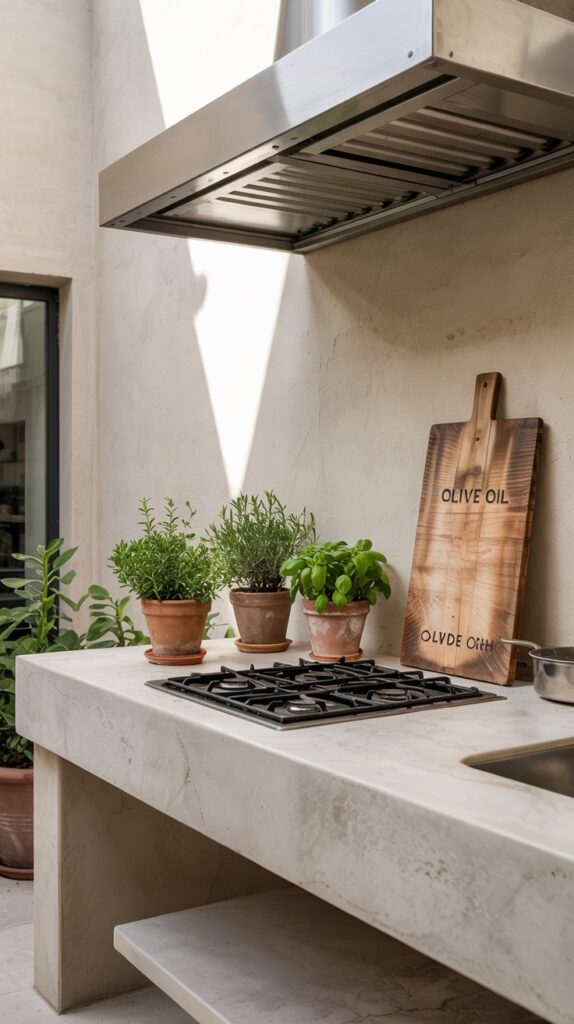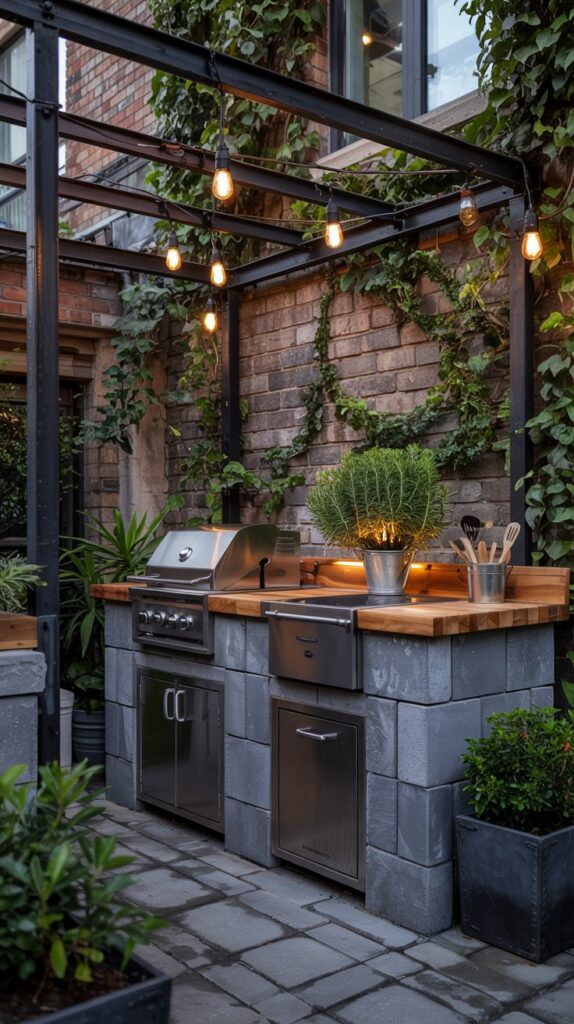Have you ever wondered how you can create a simple yet stylish outdoor kitchen with minimal fuss and maximum impact? If you’re yearning to enhance your outdoor living space while keeping it sleek and uncluttered, a minimalist approach might just be what you need. By employing clean lines, functional elements, and a touch of style, you can transform your backyard into a culinary haven, perfect for both everyday meals and delightful gatherings.
Understanding Minimalism in Outdoor Kitchens
Minimalism is all about simplicity and functionality. Rather than filling your space with an abundance of items, the goal is to focus on what’s essential and thoughtfully arrange these elements to create a cohesive and calming atmosphere. In the context of an outdoor kitchen, this involves choosing just the right components that serve both a practical purpose and add to the aesthetic appeal.
What Defines a Minimalist Outdoor Kitchen?
A minimalist outdoor kitchen thrives on the mantra of “less is more.” This means prioritizing quality over quantity, by selecting durable materials and versatile pieces that allow for efficient use of space. You’re looking for clean lines, neutral colors, and a limited use of decorative elements, keeping the focus on functionality without sacrificing style. The result is an inviting space that feels open, uncluttered, and effortlessly chic.
Benefits of a Minimalist Design
Why might you consider embracing minimalism for your outdoor kitchen? For starters, a minimalist design is not only visually appealing but also easier to maintain. With fewer elements to clean and upkeep, you can spend more time enjoying your outdoor space and less time tidying it. Moreover, a minimalist setup can boost your creativity as you focus on getting the most value from each piece, encouraging you to think outside the box and use your space more efficiently.
Planning Your Minimalist Outdoor Kitchen
Creating a stunning minimalist outdoor kitchen begins with careful planning. Before you start purchasing or installing, take the time to evaluate your needs and space constraints.
Assessing Your Space
The first step is understanding the space you have available. Whether you’re working with a sprawling backyard or a cozy patio, it’s crucial to maximize the potential of your area. Measure your space accurately and decide on the layout; will it be U-shaped, L-shaped, or perhaps a linear setup? Each has its own advantages and can be tailored to fit your specific needs.
Essential Features to Consider
Think about what elements are essential to your outdoor cooking experience. A grill is likely non-negotiable, but what about a sink, refrigerator, or prep station? Identify your must-haves based on how you plan to use the space. For a minimalist kitchen, versatility is key; consider features like a multipurpose countertop that can double as a dining area.
Budget Planning
Creating a budget is essential when designing a minimalist kitchen. Determine how much you are willing to spend and allocate funds to different components accordingly. Investing in quality materials can save you money in the long run, with less frequent replacements and repairs.
Choosing the Right Materials
Material selection plays a crucial role in establishing the aesthetic and functionality of your minimalist outdoor kitchen. You’ll want materials that not only look good but also withstand the elements.
Durable and Stylish Options
Opt for materials that are both durable and stylish. Stainless steel is a popular choice for outdoor kitchens due to its resistance to rust and ease of maintenance. For countertops, materials like granite or concrete offer both durability and an elegant look. These materials can withstand temperature changes, and their neutral tones fit perfectly with a minimalist aesthetic.
Emphasizing Natural Elements
Incorporating natural elements into your outdoor kitchen design adds warmth without the clutter. Consider using wood accents for cabinetry or seating to introduce an organic touch. Ensure that any wood used is treated to resist water and heat damage. Stone is another excellent natural material, bringing texture and endurance to your minimalist kitchen.
Sustainable Choices
If sustainability is on your radar, consider eco-friendly materials. Reclaimed wood and recycled metal are excellent choices for a minimalist outdoor kitchen. Not only do they contribute to a sustainable design, but they also add character and uniqueness to your space.
Designing the Layout
The layout of your kitchen is pivotal in determining how well the space functions and how comfortable it feels.
Creating a Functional Flow
A well-designed kitchen layout ensures a functional flow, allowing you to move between prep, cooking, and serving areas with ease. The traditional work triangle might not always apply in an outdoor setup, but the principles remain useful. Ensure that your grill, sink, and refrigerator are positioned to allow efficient movement, reducing the need to backtrack or cross paths unnecessarily.
Open and Airy Feel
The hallmark of a minimalist kitchen is its open and airy feel. Avoid enclosed areas, and instead, use open shelving to maintain a sense of space while providing practical storage. An open design not only enhances the atmosphere but also makes your outdoor space feel more connected with nature.
Incorporating Essential Appliances and Furniture
Choosing the right appliances and furniture is key to achieving a minimalist look while ensuring everyday functionality. Here’s how you can make smart choices.
Selecting Compact and Multi-functional Appliances
Compact and multi-functional appliances are ideal for a minimalist kitchen. For example, a combination grill and smoker can fulfill multiple roles, saving space and money. Portable induction cooktops can be stored when not in use, freeing up space for other activities.
Choosing Minimalist Furniture
Furniture in a minimalist outdoor kitchen should be both functional and simple. Look for sleek, streamlined pieces that serve multiple purposes. A foldable table or benches with storage underneath allow for flexibility and don’t clutter the space when not in use. Materials like metal and treated wood keep furniture durable and in line with the minimalist aesthetics.
Organizing Smart Storage Solutions
Storage is vital in maintaining the minimalist look without losing functionality. Use clever solutions like built-in cabinets under counters, hooks for hanging utensils, and stackable containers. The aim is to keep your kitchen functional while avoiding visual chaos.
Adding Style with Minimalism in Mind
Style doesn’t have to be absent from a minimalist design. With clever touches, you can introduce personality and elegance into your outdoor kitchen.
Neutral Color Palette
A minimalist kitchen often centers around a neutral color palette, utilizing shades like white, grey, and beige. These tones create a calm and cohesive look, allowing natural elements and textures to stand out without overpowering the space.
Subtle Décor Elements
Introduce subtle décor elements that add character but don’t clutter. A few well-chosen accessories such as a potted plant, minimalist art piece, or simple pendant lights can enhance the atmosphere while keeping with the minimalist theme.
Lighting for Ambiance
Good lighting is essential in creating the perfect mood in your outdoor kitchen. Use a combination of task and ambient lighting; under-cabinet lights illuminate workspaces efficiently, while string lights or lanterns add a soft glow for evening gatherings. Solar-powered lights are an eco-friendly option that combines style and practicality.
Maintaining Your Minimalist Outdoor Kitchen
Once your minimalist outdoor kitchen is set up, upkeep is essential for maintaining its beauty and functionality.
Regular Cleaning Tips
To keep your kitchen looking its best, establish a regular cleaning routine. Stainless steel surfaces need periodic wiping to prevent stains and maintain their shine. For stone or wood surfaces, use appropriate cleaners that do not damage the finish. Keeping the kitchen clutter-free involves regular sorting and organizing of utensils and cookware.
Seasonal Maintenance Considerations
Outdoor kitchens are exposed to the elements, and seasonal maintenance is crucial. Before winter sets in, consider covering your appliances or storing them indoors to protect against frost damage. In the spring, inspect your kitchen components for any wear and tear, and make repairs as needed.
Longevity Through Quality Care
Investing in quality materials pays off when you care for them properly. Occasional sealing of stone surfaces can prevent damage, while treating wooden elements with oils helps maintain their integrity. Regular checks and timely maintenance will ensure your outdoor kitchen remains a stunning and functional space for years to come.
Conclusion
Creating a minimalist yet stylish outdoor kitchen is a rewarding endeavor that enhances your living space and lifestyle. By focusing on functionality, careful planning, and beautiful yet durable materials, you can craft a space that’s both practical and inviting. This approach lets you enjoy the comfort and pleasure of outdoor dining without the clutter, making every meal or gathering a delightful affair. The balance of simplicity and style not only contributes to a serene atmosphere but also provides a perfect backdrop for making cherished memories with family and friends.

